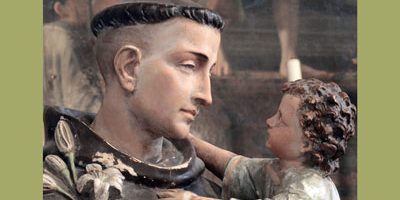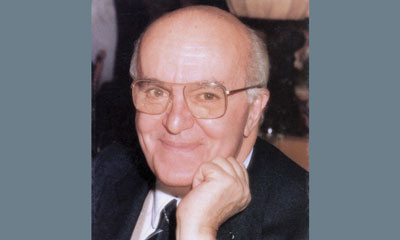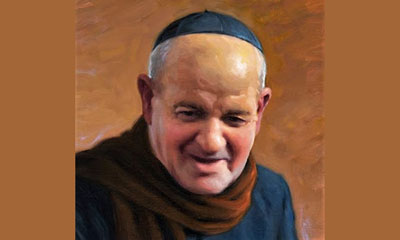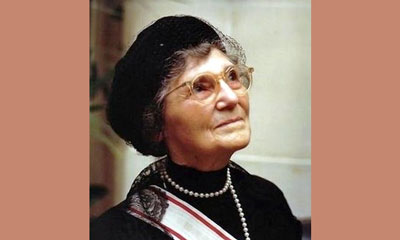July 11, 2016
Saint Anthony of Padua
Dear Friends,
Saint Anthony of Padua, also called Anthony of Lisbon after his birthplace, is “one of the most popular Saints in the whole Catholic Church, venerated not only in Padua, where a splendid Basilica has been built that contains his mortal remains, but also throughout the world. Dear to the faithful are the images and statues that portray him with the lily, a symbol of his purity, or with the Child Jesus … in memory of a miraculous apparition mentioned in several literary sources. With his outstanding gifts of intelligence, balance, apostolic zeal and, primarily, mystic fervor, Anthony contributed significantly to the development of Franciscan spirituality” (Benedict XVI, General Audience of February 10, 2010).
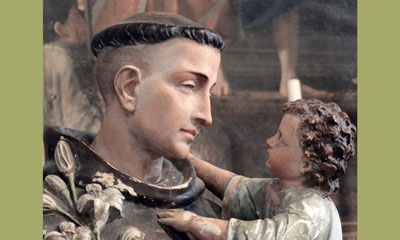 The future Saint Anthony was born in Lisbon on August 15, 1195. At Baptism, he received the name Fernando. His father, Don Martin de Bulhões, a descendent of Godfrey of Bouillon, destined him for a military career. Fernando spent his childhood close to his mother, Dona Teresa, whose tenderness was shown in her deep affection towards her family and her constant attention to them. She passed on to her son a tender devotion to the Blessed Virgin. Thus the virtues of tenderness, humility, and love of sacrifice formed in his soul, which would make him loved by all. He would later write, “Gentle is he whose spirit is not irritated and who, in the simplicity of his faith, can endure any offense patiently. Others may agitate against me, but in my heart I maintain peace.” Until the age of fifteen, he studied at the cathedral school in Lisbon. One day as he knelt on the steps of the altar, the devil appeared to him in a terrifying form. Filled with a fearless faith, the boy traced a cross on the floor, which left its the mark in the marble which became soft on contact with his flesh, so weak yet so pure. The effect was immediate—the demon disappeared instantly. This cross is still visible today in the cathedral.
The future Saint Anthony was born in Lisbon on August 15, 1195. At Baptism, he received the name Fernando. His father, Don Martin de Bulhões, a descendent of Godfrey of Bouillon, destined him for a military career. Fernando spent his childhood close to his mother, Dona Teresa, whose tenderness was shown in her deep affection towards her family and her constant attention to them. She passed on to her son a tender devotion to the Blessed Virgin. Thus the virtues of tenderness, humility, and love of sacrifice formed in his soul, which would make him loved by all. He would later write, “Gentle is he whose spirit is not irritated and who, in the simplicity of his faith, can endure any offense patiently. Others may agitate against me, but in my heart I maintain peace.” Until the age of fifteen, he studied at the cathedral school in Lisbon. One day as he knelt on the steps of the altar, the devil appeared to him in a terrifying form. Filled with a fearless faith, the boy traced a cross on the floor, which left its the mark in the marble which became soft on contact with his flesh, so weak yet so pure. The effect was immediate—the demon disappeared instantly. This cross is still visible today in the cathedral.
The three weapons
In 1210, the fifteen-year-old boy expressed his desire to become a monk and obtained his parents’ permission to enter the community of Canons Regular at the Augustinian Abbey of Saint Vincent, on the edge of the city. Their rhythm of life suited young Fernando well—prayer, spiritual reading, and work were, according to his teachers, the three weapons with which one could defeat the devil. After making his vows in 1212, he asked to be transferred to the Abbey of the Holy Cross in Coimbra. By distancing himself in this way from his friends and loved ones, he hoped to find greater tranquility of mind and interior peace to devote himself to his studies, serve the Lord, and advance in religious life. At the monastery in Coimbra, the greatly renowned cultural center of Portugal, he devoted himself to studying the Bible and the Fathers of the Church. Everything he read remained so faithfully in his memory that in a short time he demonstrated an exceptional knowledge of Holy Scripture. At the same time, his heart strengthened in the love of the Christian virtues. He became more humble, more united with God. One day as he was caring for a sick novice during the monastery Mass, Fernando heard the bell that announced the consecration. His heart leapt to his beloved Lord, who required him to remain away from the church that morning. He threw himself to his knees and adored in spirit the Christ who makes Himself sacramentally present (Cf. Catechism of the Catholic Church, nos. 1353, 1357): “O Jesus! What joy if I could be transported to the foot of your altar!” At these words, the young monk saw in a vision the sanctuary lit up with a heavenly light as the priest raised the Sacred Host.
Don Fernando became a priest, and served as porter in his monastery. In this way he made the acquaintance of a small community of Friars, who came from the community that had very recently been founded in Assisi, Italy, by Brother Francis. These new type of religious lived in poverty and straightforwardly preached the Gospel. Living in the hermitage of Saint Anthony, on the hill of Olivares, they came down to the monastery to beg alms. In 1220, the relics of the first five Franciscan missionaries, who had been sent to Morocco where they were martyred, were displayed in Coimbra. This example excited a desire in Don Fernando to imitate them and to advance on the path of Christian perfection. He then left the Augustinian Canons to take the Franciscan habit. It was at this time that he took the name of Anthony. He entered the Franciscans hoping to depart for the land of Islam, to preach the Gospel and be martyred. In fact, Brother Anthony, accompanied by another friar, departed for Morocco in December 1220. But when they arrived, they both fell ill and were forced to return after a few months. During the crossing, a violent storm pushed the little boat that was carrying them to the shores of Sicily. There, close to the Strait of Messina, the young twenty-six-year-old Portuguese first made contact with the Italy that would become his adopted country. From Messina, they reached Assisi, where he participated in the famous “Chapter of the Mats” (general chapter of the Friars Minor), which took place on Pentecost 1221, in the presence of five thousand friars.
A new star
At the conclusion of the chapter, Brother Gratian, the Provincial of Romagna, took charge of Brother Anthony, intending to send him to the hermitage of Montepaolo, in the Apennines, to celebrate Mass there, for priests were few among the Franciscans in the beginning. He found there a place of silence, a “desert of the spirit” where God led him and spoke to his heart, bringing him to know the Franciscan spirit. Anthony prayed in a cave, fasted on bread and water, and devoted himself to the humblest tasks, as did the other friars. In humility he waited on the Lord. Indeed, since his aborted attempt to preach the Gospel in Morocco, he had not dared to undertake anything. The will of God showed itself the following year, on September 22, 1222. Brother Anthony was participating, along with some other Franciscans and a few Dominicans, in a priestly ordination in the town of Forli. Invited, according to custom, to give the spiritual exhortation, the Friar Preachers declined, under the pretext that they were not allowed to speak without preparation. Then Brother Anthony was asked, and, surrendering to obedience, he presented weighty and concise arguments on ordination. His words were listened to with attention, astonishment, and joy. That very evening, Gratian wrote to Francis of Assisi: “In the Franciscan heavens a new star has just risen!” The provincial then entrusted to the young monk the mission of preaching throughout Romagna, especially in Rimini, where the Christians’ faith and unity were being threatened by the Cathar heresy. Thus in Italy, then France, began an intense and effective apostolic activity that brought many heretics back to the bosom of the Church.
For the more extreme Cathars, creation emanated from two eternal principles, one good, the other evil. From the first came the invisible world of spirits and souls; from the second came matter, which is radically evil. For more moderate Cathars, the evil principle that rules the world of matter is not an evil God, but Lucifer, the fallen angel. However, for all of them, since matter is evil, the ideal is to liberate souls from it, which in particular leads to the rejection of marriage which, by procreation, results in souls being confined in matter. The Cross of Christ and the Eucharist, which are material, were thus for the Cathars a scandal, a stumbling block (cf. 1 Cor. 1:23 and CCC no. 1336). In Rimini, a middle-class man by the name of Bonvillo was one of the greatest unbelievers. He mocked Brother Anthony and told him: “Show me by a miracle that the Eucharist is truly the Body of Christ, and I swear I will be converted on the spot.” With full confidence in the Holy Spirit, the disciple of Saint Francis accepted the challenge. “So,” exclaimed Bonville, “I have a mule. I will keep it locked up without food for three days, then I will lead it to the church square. There, I will offer it a basket of oats. You will bear a consecrated host. If my animal refuses my grain and bows before the host, I too will bend my reason before the mystery that you teach.” Brother Anthony agreed, and himself kept a fast as rigorous as the animal’s. On the appointed day, the square was packed. The monk came out of the church, bearing a monstrance. Bonvillo dragged his tottering mule with difficulty, then offered him the oats. Then Brother Anthony cried out, “Animal devoid of reason, come prostrate yourself before your Creator!” Immediately, the mule turned away from the oats and knelt before the host, remaining motionless, its head lowered, until the Friar ordered it to rise. Then the mule headed straight for the basket and hungrily devoured its contents. Imagine the Cathars’ amazement! Following Bonvillo’s lead, most of them recanted their heresy. The event, well testified to, is recounted in modern biographies of the saint.
The littlest ones
Wanting his spiritual sons—the Friars Minor—to be the littlest ones in the Church, and remembering the words of Saint Paul, that knowledge puffs up (1 Cor. 8:1), Saint Francis of Assisi initially did not want extensive theological teaching within his Order. But, faced with the gravity of the Cathar heresy, he came to understand the need for solid theological formation. Study would allow the Friars to better know and make known the teachings of Christ and of the Church. Recognizing that Brother Anthony was the monk best able to reconcile learning with the demands of piety and humility required by the Rule, Francis wrote to him: “I would like you to teach the brethren sacred theology. However, take care that the spirit of prayer is not extinguished in you or in them.” Sent to Bologna, Brother Anthony laid the foundations of Franciscan theology, which, developed by other eminent thinkers, would reach its pinnacle with Saint Bonaventure and Blessed Duns Scotus.
The birth of Christ in Bethlehem and contemplation of the Crucifixion inspired in Brother Anthony thoughts of gratitude toward God and esteem for the dignity of the human person. He wrote, “Christ, who is your life, is hanging before you, so that you look at the Cross as in a mirror. There you will be able to see how mortal your wounds were; no medicine except the Blood of the Son of God could heal them. If you look closely, you will realize how great are your human dignity and your value… Nowhere can one better understand one’s own value, than in looking into the mirror of the Cross.”
In 1224, Brother Anthony was sent to France, to Montpellier, to teach theology to the young religious of his Order. There he wrote a commentary on the Psalms. A novice, coveting this treasure of learning and pushed by the devil, stole the manuscript and fled. The author of the precious text lost the fruit of his late nights and his labors. The community grieved the departure of one of its sons, who, running away as a thief, abandoned his vocation, placing his soul in peril. Brother Anthony begged Our Lord to arouse remorse in the soul of the guilty party. Soon the fugitive reappeared, confused and penitent. Prostate at the feet of the saint, he asked for a just penance. Soon forgiven, he took his place again in the novitiate and redoubled his zeal. Popular piety seized on this incident to attribute to Saint Anthony the power to recover lost objects. One day Saint Francis de Sales answered a scoffer who was making fun of this custom: “Truly, Sir, I wish that we could make a vow to this saint to find what we lose every day: you, your Christian simplicity, and me, the humility that I neglect to practice!”
The Council of Bourges
Brother Anthony was then sent to Toulouse, to Puy-en-Velay and to Limoges, where he founded communities and became their superior. In November 1225, he was invited to participate in the provincial Council of Bourges. The purpose of this meeting, presided over by a legate of the Pope, was to find a way to restore peace to Languedoc, which was disturbed by the Albigensians (Cathars from the region of Albi), and quarrels between princes. Brother Anthony was asked to preach before the religious and civil authorities of the kingdom. Without regard for human respect, he denounced the underlying causes of the conflict that was ravaging Languedoc: religious causes, sustained by the Albigenses’ machinations; social causes, flowing from the thirst for riches and honors of the kingdom’s princes, the majority of whose subjects were living in poverty; and lastly, moral causes, which, in his opinion, were not the least of the causes. He castigated the poor examples given in this area by certain members of the nobility, but also by the clergy. Having suddenly received divine revelation about the state of the conscience of Simon de Sully, the Archbishop of Bourges, he reproached the bishops, with sound Biblical arguments, for their worldly and luxurious lives, and railed against those among them who did not know or want to protect their sheep from the dangers of error. Overwhelmed by these words of fire, Simon de Sully acknowledged his errors in a sincere confession. He became the famous prelate in whom the Pope and King Saint Louis placed their trust.
Returning to Assisi in 1227, Brother Anthony was appointed the Provincial of northern Italy, a post he would fill until Pentecost 1230. During this period, he regularly went to Padua, a town near Venice. The faith of the Paduans touched him, and he became attached to them with a bond of profound affection. Once he was replaced as Provincial, he joined a group of Dominicans and Benedictines who were tasked by Pope Gregory IX to work on the reform of clerics and religious that had been promoted by the Fourth Lateran Council (1215). During the summer of 1230, he received from his superiors the mission of going to Rome to ask the Pope to settle an open debate within the Order on the subject of the practice of poverty. After the founder’s death (1226), some Friars wished to live a poverty strictly faithful to the letter of the Rule, while others, in order to respond to new situations, wished to relax this rigor they deemed excessive. The Pope would decide in favor of the latter group. On this occasion, Brother Anthony was brought to preach before the Holy Father, who, admiring his knowledge of Scripture, exclaimed, “He will be called the Ark of the Testament and the divine depository of the Holy Scriptures.”
“An affectionate dialogue”
During this final period of his life, Brother Anthony wrote two cycles of Sermons. These are “theological and homiletical texts that echo the live preaching in which Anthony proposes a true and proper itinerary of Christian life. The richness of spiritual teaching contained in the ‘Sermons’ was so great that in 1946 Venerable Pope Pius XII proclaimed Anthony a Doctor of the Church, attributing to him the title ‘Doctor Evangelicus’, since the freshness and beauty of the Gospel emerge from these writings. … In these Sermons Saint Anthony speaks of prayer as of a loving relationship that impels man to speak gently with the Lord, creating an ineffable joy that sweetly enfolds the soul in prayer. Anthony reminds us that prayer requires an atmosphere of silence … [It] is an interior experience that aims to remove the distractions caused by a soul’s anxieties, thereby creating silence in the soul itself. According to this prominent Franciscan Doctor’s teaching, prayer is structured in four indispensable attitudes … The first step in prayer is confidently opening one’s heart to God; this is not merely accepting a word but opening one’s heart to God’s presence. Next, is speaking with Him affectionately, seeing Him present with oneself; then a very natural thing, presenting our needs to Him; and lastly, praising and thanking Him. In Saint Anthony’s teaching on prayer we perceive one of the specific traits of the Franciscan theology that he founded: namely the role assigned to divine love which enters into the sphere of the affections, of the will and of the heart, and which is also the source from which flows a spiritual knowledge that surpasses all other knowledge. In fact, it is in loving that we come to know. Anthony writes further: ‘Charity is the soul of faith, it gives it life; without love, faith dies’” (Benedict XVI, General Audience of February 10, 2010).
During Lent of 1231, the bishop of Padua asked Brother Anthony to preach daily to the inhabitants and clergy of the city. In spite of tiredness brought on by his corpulence and other infirmities, the well-known monk displayed an indefatigable zeal for the salvation of souls, preaching and then hearing confessions until evening. The churches became too small to contain the crowds that came to hear him. In the face of the growing numbers who came to listen—up to 30,000 people—the preaching soon was moved to public places. Brother Anthony, notes Benedict XVI, “was thoroughly familiar with the shortcomings of human nature, with our tendency to lapse into sin, which is why he continuously urges us to fight the inclination to avidity, pride and impurity; practicing instead the virtues of poverty and generosity, of humility and obedience, of chastity and of purity. At the beginning of the 13th century, in the context of the rebirth of the city and the flourishing of trade, the number of people who were insensitive to the needs of the poor increased. This is why on various occasions Anthony invites the faithful to think of the true riches, those of the heart, which make people good and merciful and permit them to lay up treasure in Heaven” (ibid.). “O rich people”, he urged them, “befriend… the poor … It will subsequently be they who receive you in the eternal tabernacles in which is the beauty of peace, the confidence of security and the opulent tranquility of eternal satiety” (ibid.). In another sermon, to turn sinners away from hell, Saint Anthony depicted the punishment for avarice and lust, the flaws he considered the most common. Speaking about the parable of the wedding of the king’s son, he commented on the king’s sentence on the invitee who was not dressed in wedding garments: Bind him hand and foot, and cast him into the outer darkness (Mt. 22:13). There, there will be tears, from eyes that went astray in vanity, and grinding of teeth that enjoyed voraciousness and devoured the goods of the poor.”
A last song of love
Following Saint Anthony’s preaching, so many wished to confess that there were not enough priests to hear them. The saint obtained from Paduan magistrates the release of insolvent debtors who were imprisoned at the request of usurers until their debt had been repaid. But so much effort eventually exhausted his body, already weakened by illnesses and fasts. In May, he received permission to withdraw to a quiet place north of Padua. A shelter was built there for him between the branches of a walnut tree, for him to pray and prepare himself to see God face to face (1 Cor. 13:12). On June 13th, feeling his strength failing him, he had himself brought to his monastery in Padua. Arriving at the gates to the city, he was so weak that he had to stop at the Poor Clare monastery in Arcella, where he received Extreme Unction. He then did his best to sing one last time to his Queen, the Virgin Mary, a last song of love. Then his face lit up. He said he was seeing his Lord Jesus, calling him to Himself.
At his tomb, the scenes of enthusiasm that had accompanied his preaching were repeated. Many miracles took place, and the people’s fervor grew daily, to the point that the bishop and the civil authorities of Padua decided to send a delegation to ask the Pope to canonize Brother Anthony. During the inquiry, fifty-three miracles attributed to his intervention were recognized. On May 30, 1232, just a year after his death, an exceptionally brief period, Gregory IX proclaimed Anthony of Padua a saint.
Following the saint’s example, let us be inspired by Saint Peter’s exhortation: In your hearts reverence Christ as Lord. Always be prepared to make a defense to anyone who calls you to account for the hope that is in you, yet do it with gentleness and reverence (1 Pet. 3:15).


